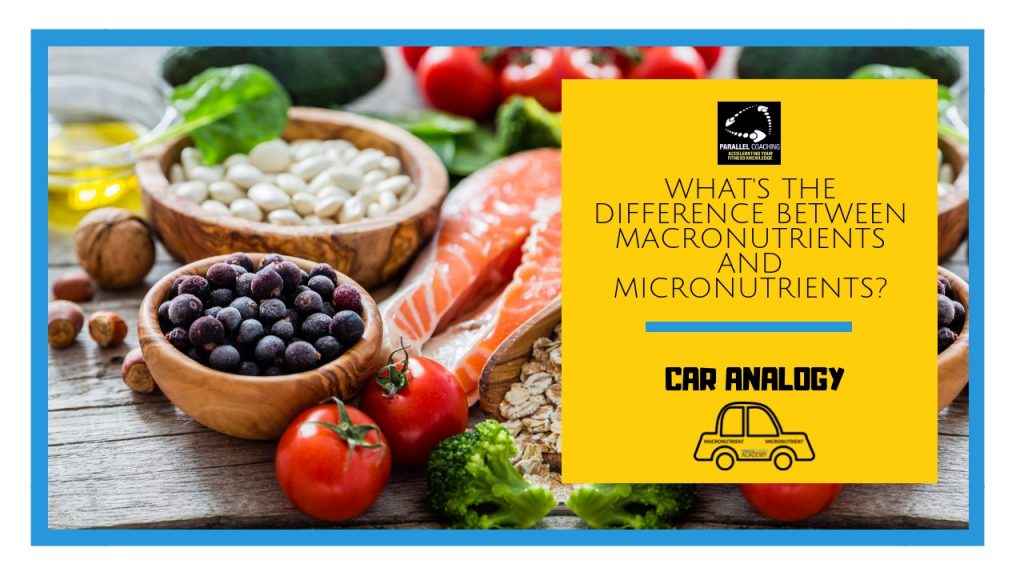This blog will explore the difference between macronutrients and micronutrients, which is crucial in the preparation for the Level 3 Nutrition Exam.
You’ll explore:
- How many exam questions to expect in your Level 3 Nutrition exam
- A 6 minute video tutorial explaining macronutrients and micronutrients
- Understanding nutrition as a fuel
- Three mock questions to test your knowledge
Commonly the level 3 Nutrition exam features 40 multiple-choice questions. You can expect 4 to 6 exam questions around Understanding the Macronutrient and Micronutrient Group in your final exam so it’s key you understand the “Ins & Outs” to ensure you pass.
First Up, PRESS PLAY
and take notes as you go through today’s tutorial making this complex topic, super simple!
Let’s make this easy to remember:
The way macronutrients and micronutrients are used can be explained in an example of how a car works.
When your exam invigilator says, “you may now begin your exam”, use the first minute to write down your brain dump [if you’re unfamiliar with what a brain dump is CHECK IT OUT HERE] and draw a picture of a car, and write macro and micro on it.
When you get to the questions about macronutrients and micronutrients you can use the brain dump to ensure you are on the right road – pun intended.

The way we operate our bodies is similar to a car operates.
Just like a car constantly needs to fill up with petrol, our body constantly needs to fill up with fuel.
The body’s main fuel source comes from macronutrients.
This includes carbohydrates, fats, and proteins.
It’s these 3 macronutrients that provide the fuel or the calories for our bodies on a day-to-day basis.
Now let’s explore how Micronutrients relate to the car!
Micronutrients to the body are like engine oil to the car
The oil in a car cools, cleans and lubricates the components of the engine so it does not seize up and remains 5* shiny and in working order.
Without engine oil, the engine will not run (for very long).
This is very similar to what micronutrients do in the body.
Micronutrients are responsible for the smooth operation of bodily processes and functions. Micronutrients include vitamins, minerals, antioxidants, and phytonutrients.
Macronutrient and Micronutrient Mock Questions
Test your knowledge by answering these three mock questions: answers are at the bottom of the blog.
QUESTION 1: How many calories does a single gram of fat provide?
A. 4 kcals
B. 7 kcals
C. 9 kcals
D. 11 kcals
QUESTION 2: Carbohydrate foods are beneficial in the diet because?
A. They provide a valuable source of energy
B. They are the building blocks of the body
C. They strengthen the immune system
D. They are rich in vitamins A, D, E and K
QUESTION 3: Which of the following is a micronutrient?
A. Carbohydrates
B. Fats
C. Vitamins
D. Protein
ANSWERS
Question 1= C, Question 2 = A, Question 3 = C
If you want more mock questions like this, then you can download more Free Mock Questions: DOWNLOAD NOW
Need More Help with your Nutrition Exam Revision?
For Trainee FITPROS Taking Their L3 Nutrition Exam.
Learn, Revise & Pass Your Level 3 Nutrition Exam In Under 10 hours
(Without Having To Spend Hours Revising Or Feeling Overwhelmed)
If you want to get your revision structured, learn everything you need to know and feel confident on exam day, then click the link below:
https://courses.parallelcoaching.co.uk/products/level-3-nutrition-revision-bootcamp/

Dedicated to More
Hayley “macronutrients and micronutrients” Bergman
Parallel Coaching
P.S. You can also find us on the following platforms:
Instagram: https://www.instagram.com/parallelcoaching
Facebook: https://www.facebook.com/ParallelCoaching
Twitter: https://twitter.com/ParallelCoach
YouTube: http://bit.ly/2F1Z1bs

